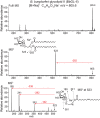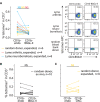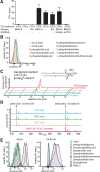CD1b presents self and Borrelia burgdorferi diacylglycerols to human T cells
- PMID: 30854633
- PMCID: PMC6594241
- DOI: 10.1002/eji.201847949
CD1b presents self and Borrelia burgdorferi diacylglycerols to human T cells
Abstract
Lyme disease is a common multisystem disease caused by infection with a tick-transmitted spirochete, Borrelia burgdorferi and related Borrelia species. The monoglycosylated diacylglycerol known as B. burgdorferi glycolipid II (BbGL-II) is a major target of antibodies in sera from infected individuals. Here, we show that CD1b presents BbGL-II to human T cells and that the TCR mediates the recognition. However, we did not detect increased frequency of CD1b-BbGL-II binding T cells in the peripheral blood of Lyme disease patients compared to controls. Unexpectedly, mapping the T cell specificity for BbGL-II-like molecules using tetramers and activation assays revealed a concomitant response to CD1b-expressing APCs in absence of BbGL-II. Further, among all major classes of self-lipid tested, BbGL-II responsive TCRs show strong cross-reactivity to diacylglycerol, a self-lipid antigen with structural similarities to BbGL-II. Extending prior work on MHC and CD1b, CD1c, and CD1d proteins, this study provides evidence for cross-reactive CD1b-restricted T cell responses to bacterial and self-antigens, and identifies chemically defined targets for future discovery of self and foreign antigen cross-reactive T cells.
Keywords: CD1b; Lyme disease; T cells; antigen specificity; lipid antigen.
© 2019 The Authors. European Journal of Immunology published by WILEY-VCH Verlag GmbH & Co. KGaA, Weinheim.
Conflict of interest statement
The authors declare no commercial or financial conflict of interest.
Figures





References
-
- Calabi, F. , Jarvis, J. M. , Martin, L. and Milstein, C. , Two classes of CD1 genes. Eur. J. Immunol. 1989. 19: 285–292. - PubMed
-
- Dougan, S. K. , Kaser, A. and Blumberg, R. S. , CD1 expression on antigen‐presenting cells. Curr. Top Microbiol. Immunol. 2007. 314: 113–141. - PubMed
-
- Rossjohn, J. , Gras, S. , Miles, J. J. , Turner, S. J. , Godfrey, D. I. and McCluskey, J. , T cell antigen receptor recognition of antigen‐presenting molecules. Annu. Rev. Immunol. 2015. 33: 169–200. - PubMed
-
- Beckman, E. M. , Porcelli, S. A. , Morita, C. T. , Behar, S. M. , Furlong, S. T. and Brenner, M. B. , Recognition of a lipid antigen by CD1‐restricted alpha beta+ T cells. Nature 1994. 372: 691–694. - PubMed
Publication types
MeSH terms
Substances
Grants and funding
LinkOut - more resources
Full Text Sources
Medical
Research Materials
Miscellaneous

